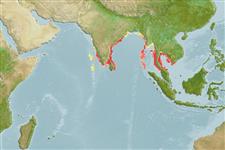Actinopterygii (ray-finned fishes) >
Perciformes (Perch-likes) >
Sillaginidae (Smelt-whitings)
Etymology: Sillago: From a locality in Australia .
Environment / Climate / Range
Ecology
Marine; demersal; non-migratory; depth range 0 - 10 m (Ref. 6205). Tropical, preferred ?; 24°N - 6°N, 68°E - 106°E (Ref. 6205)
Eastern Indian Ocean: India and Thailand. Sillago intermedius is similar to Sillago sihama.
Size / Weight / Age
Maturity: Lm ? range ? - ? cm
Max length : 20.0 cm SL male/unsexed; (Ref. 6205); common length : 20.0 cm SL male/unsexed; (Ref. 9679)
Dorsal
spines
(total): 12;
Dorsal
soft rays
(total): 21-22;
Anal
spines: 2;
Anal
soft rays: 21 - 22;
Vertebrae: 34. Swim bladder with two posterior extensions; anterior margin with two divergent blind tubes that extend to the basioccipital above the auditory capsule; an anterolateral extension on each side, each sending a blind tubule anteriorly and then recurving posteriorly along the abdominal wall as a simple tube to terminate just posterior to the duct-like process.
Occur inshore on open silty bottom (Ref. 6205). Oviparous (Ref. 205).
Life cycle and mating behavior
Maturity | Reproduction | Spawning | Eggs | Fecundity | Larvae
McKay, R.J., 1992. FAO Species Catalogue. Vol. 14. Sillaginid fishes of the world (family Sillaginidae). An annotated and illustrated catalogue of the sillago, smelt or Indo-Pacific whiting species known to date. Rome: FAO. FAO Fish. Synop. 125(14):87p. (Ref. 6205)
IUCN Red List Status (Ref. 115185)
CITES (Ref. 94142)
Not Evaluated
Threat to humans
Harmless
Human uses
Fisheries: subsistence fisheries
More information
Common namesSynonymsMetabolismPredatorsEcotoxicologyReproductionMaturitySpawningFecundityEggsEgg development
ReferencesAquacultureAquaculture profileStrainsGeneticsAllele frequenciesHeritabilityDiseasesProcessingMass conversion
Tools
Special reports
Download XML
Internet sources
